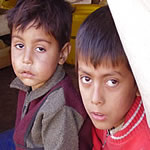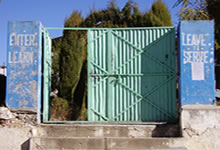Special Report: Relief Camp Schools - A New Beginning

|
Lat:
34:22.998000
Long:
73:21.000000
Special Report: Relief Camp Schools - A New
Beginning
School: Happy Child School , Bamphora
Relief Camp, Balakot.
Organization: Sarhad Rural Development Program (SRSP) Community: Earthquake survivors Date: 03rd December 2005 Camp leader: Mr. Baba Farooq Teachers: 2 No. of students: 67 mixed No. of Classes: 1 to 5 School: Battal Boy’s High School,
Battal The Providers A life turned upside down. A foreign place, populated by
people you;ve never seen before. Help came from across the globe to rebuild shattered lives. International NGOs, local people and ‘professional’ volunteers from Tsunami areas. Tent cities were soon sprawling across the landscape, arresting every piece of flat land. Families moved in, tradition was swallowed and new lives begun. Surprisingly education quickly took priority. Within a week, local teachers were meeting to establish new schools and within a month almost every camp had a school institutionalized. The first few weeks were climatic and I can’t imagine how the people felt. Schools served dual functions; as a place of learning during the day and as a shelter for new arrivals at night. While snow fell in the high mountains and new roads opened up, camps were being inundated with fresh arrivals well into December. Under these conditions no parent wanted their child amidst the carnage of their camp. And yet, children were still slow to arrive. Over 17,000 children were estimated to have been killed when the ground shook and their walls collapsed around them. It was early on Saturday morning and classes had just begun. No school was left unscathed. Approximately 95% were destroyed. Undoubtedly no child was quick to return. Happy Child School Despite the carnage I decided to continue my ride and to film those schools affected by the Earthquake to see what was needed. The first school we visited was ‘ Happy Child School ‘ at Balakot, near the Epi-centre of the quake. It was the 03rd of December, eight weeks after the disaster. The school was located in a relief camp run by Sarhad Rural Development Program (or SRSP), a local organization respected throughout the international community for its development work in North Pakistan . Two hundred families lived in the camp and their children attended one of two schools. The one we visited was the smaller one, with two huge tents provided by the Salvation Army in a tiny compound. Thirty tiny students sat on dirty matting yelling English when we arrived. The ‘teacher’ was a fifteen year old boy.; because there was no educated person in Balakot able to replace him. He had guts and still gave the kids (mixed classes from 1-5) basic Maths, Urdu, English, Science and Islamiat. I had to wonder if I was fifteen could I have done such a good job? However, only thirty out of forty students had showed today. As at Al Fajr’s school (link), kids were slow in returning to a place of they only associated with death. In this case the weather was also becoming cold and the lack of a ‘proper’ teacher meant parents were even now not sending their children to the school. The future didn’t look good. Over the previous few weeks, I’d collected over 2000Rs in donations for such a school from the Pakistani public and I gladly presented it to HCS hoping it would help. The High School of Battal
Over six weeks later, I spoke with the staff at the SRSP camp where Happy Child School was located. There were now two proper teachers at the school and despite 5-10 ft of snow, attendance at HCS had increased to 67 students! The SRSP staff couldn’t understand it. So here is a final point. In Pakistan there are 50 million people who cannot read or write. There are 100million out of school or working children in the world and six million are in Pakistan . Two thirds of all women (aged 10+) are illiterate and the drop out rate from primary school is 50%. For the common man in Pakistan, life is a daily affair of many obstacles. Wages are low and unemployment sky high. Many families cannot often afford to feed their offspring. Obtaining a skill is seen as a better investment for a child than a long term education. A skill can feed that mouth today, an education may feed it tomorrow. Life is uncertain. The relief camps take away that uncertainty because the organizers provide everything for the earthquake survivors. Although life is still harsh, obstacles such as lack of food, shelter and warm clothing have been taken away. Poor families are now seizing the opportunity for their children to have an education and school attendances increase, even in the harshest weather. Furthermore people know that the organisations running the camps care about them and their schooling. Teachers are volunteers and actually care about the children in the camps. Parents don’t need any more persuading. Most of the schools I have visited so far go out of their way to create a demand among the people by adapting an education system to match their way of life, (e.g. Godh, PSTA). The Earthquake survivors have a tough life, but not one as complicated as before. Now the demand for education has increased and the NGOs cannot create enough schools. For the Pakistan Government to simply build and staff schools is not enough. Thousands of examples nationwide show that communities need a tough support structure to maintain their children through school. They need good quality schooling with teachers who care. Providing a lunchtime meal and a smile maybe all it takes. CONTACT:Mr. Baba Farooq, SRSP, Team Leader,
Balakot CONTACTMr. Nadir Shah,(Sungi Foundation) |

